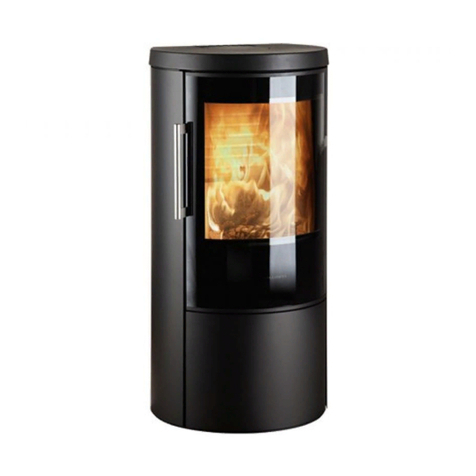
Page 10 of 20 pages
Model Weight Height Width Depth
HWAM 4340 140 kg 120,3 cm 58,7 cm 47,9 cm
HWAM 4340 with natural stone cladding 198 kg 124,5 cm 58,7 cm 47,9 cm
HWAM 4340 with soapstone cladding 227 kg 124,5 cm 58,7 cm 47,9 cm
Floor plate
European, national and local regulations must be observed in terms of the size and thickness of a non-
combustible floor covering the floor in front of the combustion chamber opening. Ask your HWAM
retailer for assistance.The combustion chamber opening is 38.2 cm wide.
Distance to combustible materials
Min. distances - uninsulated flue gas pipe
(drawing A)
HWAM 4340
1. Recommended for brick wall 10 cm
1. For combustible back wall 11 cm
2. For combustible side wall 25 cm
1.To combustible wall,corner installation, 45º 13 cm
3. Distance to furnishings in front 120 cm
Remember to pay attention to applicable regulations concerning the required distance
between the wall and smoke pipe.
The distance to a brick wall is set to faciliate the servicing of the HWAM®SmartControlTM..
Please be aware that not all glass parts are heat-resistant. For this reason, a glass wall should sometimes
be treated as a combustible wall, in which case we ask you to contact your local chimney sweep or glass
producer to hear at what distance the stove should be kept from glass.
Requirements for chimney and smoke pipe
The height of the chimney must ensure sufficient draught and prevent any smoke nuisance.As a general
rule, satisfactory draught conditions are achieved if the chimney is 4 m above the stove and at least 80
cm above the ridge. If the chimney is placed at side walls, the top of the chimney should always be higher
than the ridge or the tallest point of the roof.Always be aware of any national and/or local regulations
applying to thatched roofs and the location of the chimneys.
The stove requires a minimum draught of 12 Pa (measured at EN 13240 measurement point).If measured
just above the smoke flue socket, the chimney draught must be 18-20 Pa.
The chimney must have a minimum clearing of Ø 150 mm. The chimney must be provided with an
easily accessible cleaning door.The chimney and flue duct must be of flue class T400 and be CE marked.
Furthermore, it must have obtained the classification of G in soot fire testing.The required distance to
combustible material must be complied with in accordance with the brand label.Ask your HWAM retailer
for further information.
Connection to chimney
All the stoves have both back and top outlet that can be connected to an approved steel chimney on top or
directly out at the ear to a chimney.
Make sure that the chimney is tight and that no false draft is caused around neither the cover plate, in
connection with a covered smoke outlet, nor the cleanout door and pipe connections. Please note that
bent and/or horizontal smoke pipes will reduce the effect of the chimney draft.





























